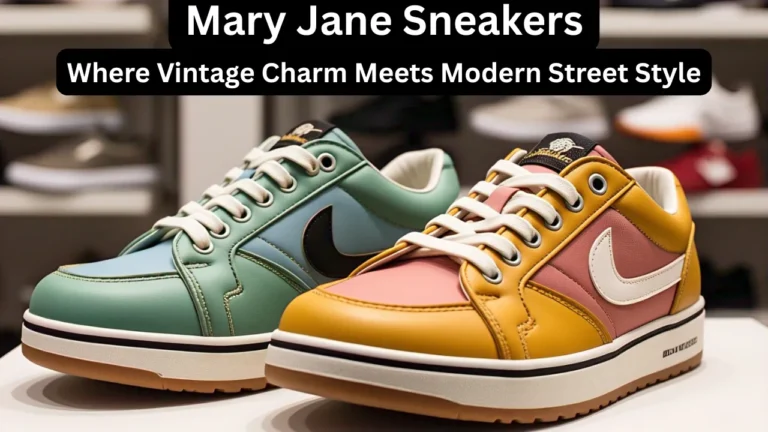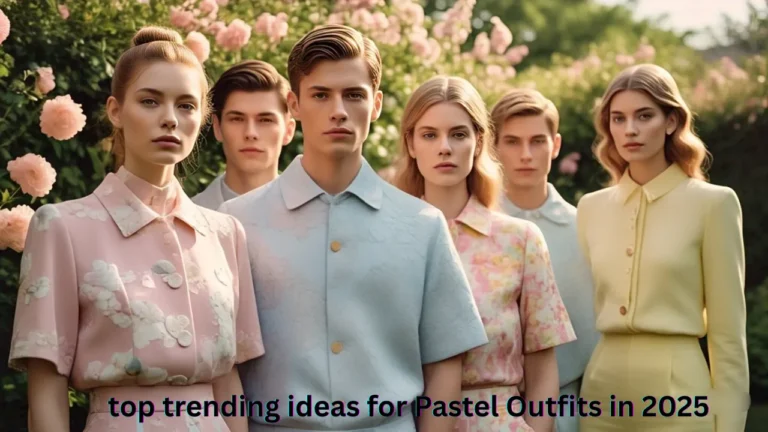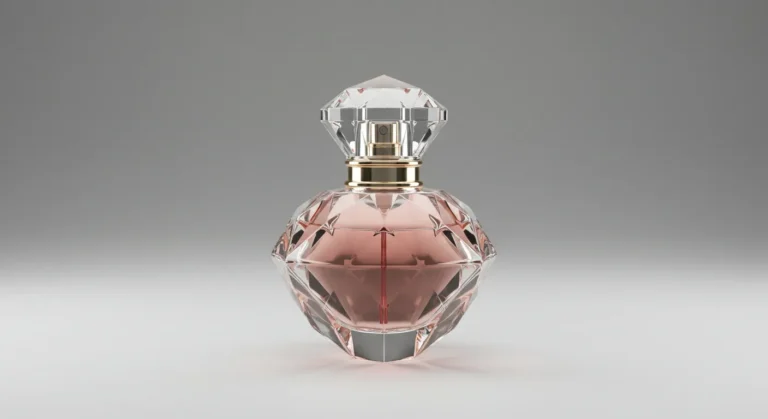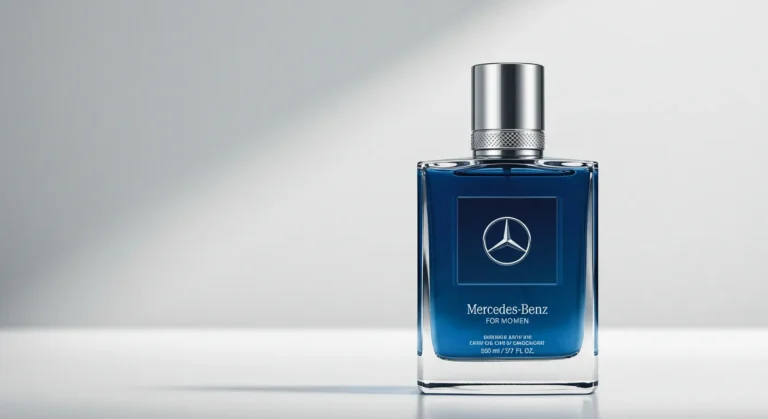best Oscar Fashion 2025 The Ultimate Red Carpet trends
Introduction
Oscar fashion has always been more than red carpet glamour it’s a visual chronicle of cultural change, social progress, and creative evolution. As we enter 2025, the world of celebrity style has reached a dazzling new zenith. From tradition to transformation, the Academy Awards continue to set the tone for global fashion movements. In this high-stakes arena where elegance meets innovation, Oscar fashion 2025 is rewriting the narrative of luxury and personal expression.
Looking back, the Oscars have long functioned as fashion’s most-watched runway. From Audrey Hepburn’s timeless Givenchy dress in 1954 to Billy Porter’s tuxedo gown in 2019, each era has left its mark on what’s acceptable, applaudable, and iconic. But the 2025 Oscar Fashion are different — not just a reflection of the year’s style but a declaration of where fashion is headed.
The seeds of 2025’s Oscar fashion revolution were planted during the pandemic years when digital red carpets forced designers, stylists, and celebrities to reimagine what glamour means in a hybrid world. Since then, we’ve seen a growing emphasis on individuality, authenticity, sustainability, and boundary-pushing design. Now, in 2025, those trends have crystallized into a bold aesthetic that’s both nostalgic and futuristic — equal parts homage and innovation.
What makes Oscar fashion 2025 particularly remarkable is its embrace of diversity in all forms. On this year’s red carpet, age, size, gender, and ethnicity were celebrated with never-before-seen inclusivity. Gone are the days when only a narrow definition of beauty was showcased. Today, stars are using fashion as a tool for storytelling, activism, and cultural pride. Whether through Afro-futuristic gowns, gender-fluid tuxedos, or reimagined classic silhouettes, celebrities are more intentional than ever with their style choices.
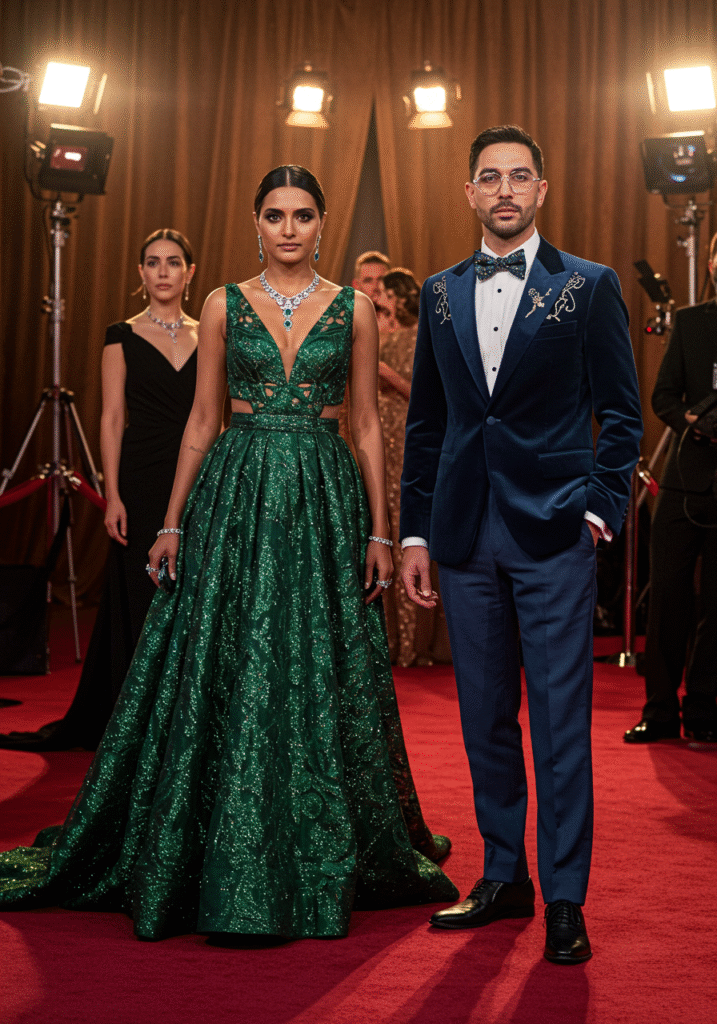
Technology, too, is playing an increasingly important role. From AI-assisted fabric design to augmented reality styling, Oscar fashion 2025 blurs the line between fashion and tech. Some gowns changed colors under the lights, while others incorporated smart textiles that responded to movement or temperature. These are no longer clothes — they’re experiences, and they’re designed to be shared, streamed, and saved across platforms.
Another evolution is the shift in who’s commanding attention. In previous years, Oscar fashion was dominated by a handful of legacy designers and Hollywood A-listers. But in 2025, emerging designers from underrepresented communities made a powerful statement. Social media stars walked alongside Oscar Fashion nominees, and upcycled couture drew as much praise as diamond-studded gowns. This democratization of glamour shows how the fashion industry is responding to new voices and values.
It’s also impossible to overlook the increasing presence of sustainability in Oscar fashion. Vintage pieces, repurposed fabrics, and biodegradable materials were front and center this year. Celebrities no longer dress just to impress — they dress to influence, advocate, and innovate. The red carpet is becoming a green carpet, reflecting the broader societal shift toward conscious consumerism.
Ultimately, the Oscar Fashion in 2025 mark a turning point. No longer just a visual spectacle, the red carpet has evolved into a curated message board for social change, artistic risk, and personal vision. The gowns are grander, the statements bolder, and the attention to detail more precise than ever. This isn’t just about fashion — it’s about the future.
As we move deeper into the highlights of Oscar fashion 2025, get ready to explore the unforgettable looks, trailblazing designers, and trendsetting moments that defined the night. From jaw-dropping couture to digital-age innovation, the Oscar Fashion have once again proven why they remain fashion’s most influential stage.
Red Carpet Royalty
The 2025 Oscar Fashion red carpet was a theater of fashion royalty. From Hollywood veterans to emerging icons, the event was packed with unforgettable fashion moments that instantly went viral. This year’s best-dressed celebrities didn’t just wear outfits — they delivered cinematic style performances. And with the world watching every sequin, slit, and silhouette, these stars made history under the glare of the world’s most glamorous spotlight.
Zendaya, often dubbed the queen of contemporary red carpet Oscar Fashion, stunned in a sculptural silver gown by Iris van Herpen that seemed to defy physics. Featuring kinetic pleating that shimmered with every step, the dress was both futuristic and organic — a true reflection of where fashion is headed. The look was accessorized with minimalist platinum cuffs and a slick back wet-hair look that kept the focus on her ethereal ensemble.
Timothée Chalamet, never one to shy away from bold statements, broke red carpet norms once again in a backless Alexander McQueen tuxedo jacket paired with sheer lace trousers. His gender-fluid fashion sense continues to redefine menswear, pushing boundaries with ease and elegance. His look trended within minutes and became a symbol of 2025’s androgynous couture moment.
Rihanna turned the carpet into a celebration of motherhood and high fashion, appearing in a deep burgundy custom Balenciaga gown that featured an exaggerated train and a sculpted bodice. Embellished with crystals that caught every camera flash, the piece honored her Caribbean roots through subtle embroidery and elevated craftsmanship.
Florence Pugh, meanwhile, leaned into drama with a feathered Valentino gown in a vibrant electric blue. The plunging neckline and high-leg slit made headlines, but it was her confidence and effortless styling that made her one of the night’s standout stars. She completed the look with art-deco earrings and platform heels that peeked through with every step.
Newcomer Jacob Elordi was the epitome of elegance in a cream satin suit by Tom Ford, paired with a black silk bowtie and vintage Cartier brooch. His look evoked the old-school Hollywood heartthrob aesthetic with a 2025 twist — proving that sometimes, simplicity with refinement wins the night.
Lady Gaga, no stranger to risk-taking, arrived in a wearable piece of art: a structured Schiaparelli dress featuring a golden corset molded into the shape of anatomical muscle structures. It was a bold statement on strength and vulnerability and instantly drew comparisons to performance art — fashion elevated to its purest form of storytelling.
In an age where stylists and social media dictate the conversation, the 2025 red carpet celebrated individuality above all else. What united the best-dressed list wasn’t color, silhouette, or brand — it was intention. Each celebrity used fashion not just to be seen but to say something, whether about gender, culture, sustainability, or personal evolution.
These best-dressed icons didn’t follow trends — they created them. Their presence on the carpet defined Oscar Fashion 2025 and pushed global red carpet standards to dazzling new heights.
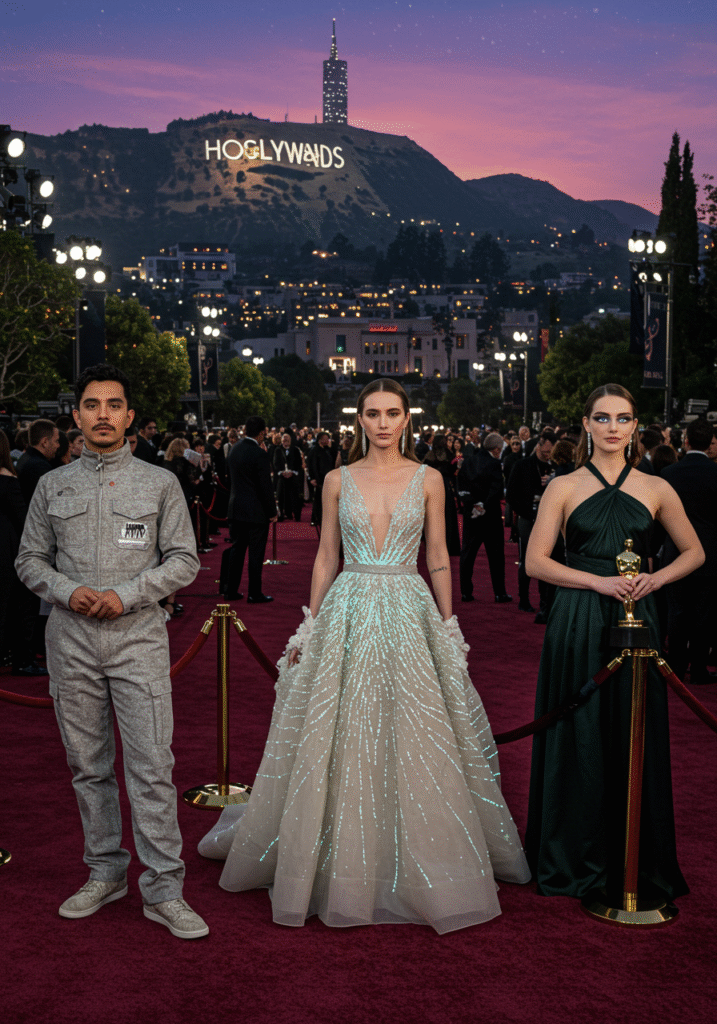
Designer Domination
Behind every show-stopping red carpet moment is a creative powerhouse — and in 2025, several fashion houses stood at the forefront of Oscar glory. The Oscars have always been a key battleground for designers seeking cultural validation and viral fame, and this year, the competition was fierce, with innovation, sustainability, and drama taking center stage.
Valentino was one of the undisputed champions of the night, dressing a spectrum of A-listers with boundary-breaking designs. Creative Director Pierpaolo Piccioli continued to redefine couture by combining surreal silhouettes with romantic maximalism. From Florence Pugh’s electric feathered gown to the muted pastel masterpieces seen on supporting actresses, Valentino proved it could marry fantasy with fierce individuality.
Balenciaga made a powerful comeback in 2025, reclaiming its red carpet dominance after a brief hiatus from mainstream award shows. Under the new direction of a culturally diverse design team, the label re-emerged with fresh vision. Rihanna’s regal appearance in a Balenciaga gown fused architectural volume with Caribbean soul, reminding the industry of the brand’s ability to combine scale with story.
Schiaparelli solidified its role as fashion’s most avant-garde storyteller. Known for its surrealist approach, the house’s 2025 creations included anatomical illusions, optical tricks, and gilded textures that transformed the human body into wearable sculpture. Lady Gaga’s Schiaparelli ensemble was a direct nod to this narrative — daring, cerebral, and memorable.
Meanwhile, Iris van Herpen, long respected for her technological artistry, captivated audiences with gowns that felt alive. Zendaya’s look — part biomorphic fantasy, part futuristic armor — was a crowning moment for the label. Utilizing 3D printing and kinetic embroidery, van Herpen’s pieces reinforced the growing intersection of couture and computational design.
LVMH-owned Louis Vuitton and Dior also had a strong presence. Dior, with its commitment to classicism fused with modern touches, delivered elegant but experimental gowns for several presenters. Louis Vuitton, on the other hand, leaned into metallics, art-deco inspiration, and genderless tailoring for its Oscar clientele.
A surprise entrant into the red carpet elite this year was Hanifa, a Black-owned label that has steadily gained cult status. Known for its digital-first debut and inclusive ethos, Hanifa dressed rising stars and influencers in vibrant, form-hugging gowns that celebrated the beauty of Black femininity and digital innovation alike.
What these designers all shared in 2025 was not just exceptional craftsmanship, but relevance. Each one spoke to a cultural undercurrent — be it sustainability, diversity, futurism, or tradition — and translated it into fashion that resonated far beyond the runway.
Trending Colors and Fabrics
Fashion is often a mirror, and at the 2025 Oscars, it reflected a world in flux — optimistic, bold, and deeply individualistic. The colors and fabrics that dominated the red carpet were expressive of renewal, rebellion, and rootedness. If 2024 leaned into soft pastels and subdued minimalism, 2025 was all about emotional vibrancy and experimental textures.
The standout color of the night was a rich molten copper — a shade that exuded warmth, glamour, and edge. Worn by multiple stars including Tessa Thompson and Letitia Wright, copper tones shimmered under the lights, capturing attention with their almost liquid-metal effect. It was both earthy and otherworldly, suggesting a rebirth of metallics in more organic hues.
Electric blue and neon chartreuse were other breakout shades. These high-voltage colors brought energy and youthfulness to the red carpet, especially when paired with minimal accessories and clean silhouettes. They were a bold departure from the safe blacks and reds of years past, signaling a collective hunger for freshness and individuality.
White also made a massive return — but this time, not as a background color. Structured white gowns with sculptural cuts and layered organza created ethereal effects. Symbolically, it reflected purity, hope, and futuristic minimalism — all central to Oscar fashion in a post-pandemic, AI-integrated world.
Fabric choices were equally daring. Liquid silk, laminated taffeta, and recycled metallic mesh were everywhere. Designers leaned heavily into fabrics that moved dramatically with the body or played with light, enhancing the cinematic feel of red carpet walks. These materials photographed beautifully, making them ideal for both in-person and digital fashion moments.
One standout textile trend was the use of 3D embroidery and holographic overlay. These elements gave gowns a dynamic quality — changing appearance as the star turned or as light bounced across them. This wasn’t just fashion; it was a multi-sensory experience designed to go viral.
Even more prominent was the use of sustainable materials — not just organic cotton or hemp, but advanced textiles made from seaweed, pineapple fibers, and even lab-grown leather. These fabrics didn’t just reduce environmental impact — they elevated couture to a whole new level of innovation.
Textures ranged from frothy tulle and delicate chiffon to rich velvet and laser-cut neoprene. This variety reflected the growing rejection of fashion rules. No longer confined to “seasonal” fabrics or color codes, Oscar fashion 2025 was a full-spectrum celebration of what it means to dress without boundaries.
Statement Pieces
In an age of viral media and cultural micro-movements, playing it safe on the red carpet is no longer an option. At the 2025 Oscars, statement pieces were not just accessories or stylistic flourishes — they were fashion manifestos. From oversized silhouettes to subversive accessories, this year’s red carpet was overflowing with bold risks that paid off in unforgettable ways.
First, the gowns. While elegance has always been the foundation of Oscar fashion, volume and asymmetry reigned in 2025. One of the most talked-about looks was worn by Anya Taylor-Joy, who stunned in a gravity-defying Viktor & Rolf couture dress with architectural shoulders and a cascading train made of mirrored panels. The dress, inspired by shattered glass, was a commentary on breaking beauty standards — literally and symbolically.
Similarly, Janelle Monáe delivered drama in a genderless hybrid ensemble: half ballgown, half tailored blazer. Designed by Harris Reed, the look played with proportion and duality — feminine and masculine, classic and modern. Her bold fashion statements continue to blur lines in ways that feel fresh, political, and entirely on-brand.
Accessories also made headlines. Gone were the days of understated clutches and delicate diamonds. Instead, bold neckpieces, elaborate headgear, and custom wearable tech turned heads. Emma Stone wore a choker embedded with digital sapphire micro-screens that displayed abstract animations — a collaboration between Bulgari and an emerging AI-art startup. It wasn’t just jewelry; it was interactive art.
Lupita Nyong’o, never one to shy away from drama, carried a clutch shaped like a sculpted African mask — handcrafted by a Kenyan artist and symbolizing ancestral elegance. This blend of heritage and haute couture was a defining theme across many looks at this year’s ceremony.
Footwear, often hidden beneath floor-length gowns, finally got its moment thanks to sheer overlays and high-low hemlines. Stars like Florence Pugh and Doja Cat wore jeweled platforms and sculpted heels that looked like museum pieces. Even men experimented: Donald Glover rocked gold-embossed monk-strap boots beneath a velvet suit, adding just the right touch of rebellion.
One of the boldest moves came from Hunter Schafer, who wore a nearly nude dress made from biodegradable mesh and strategically placed crystals. Designed by sustainable futurist brand Auroboros, the outfit sparked heated debate but also deep admiration. In an era where the fashion industry is undergoing environmental reckoning, Schafer’s choice was bold — and timely.
These statement pieces weren’t gimmicks. They were deliberate decisions made by stars and stylists who understand that the Oscars are no longer just about “who are you wearing?” — they’re about why. In 2025, celebrities are dressing with purpose, using fashion to speak about identity, politics, art, and evolution. The results? Electrifying.
Menswear Revolution
If there’s one undeniable shift in Oscar fashion 2025, it’s the revolution in menswear. Long gone are the cookie-cutter tuxedos and neutral palettes of past years. Today’s male celebrities are embracing style with the same level of creativity, flair, and freedom once reserved only for women. The result? A new golden age of male red carpet fashion.
Timothée Chalamet, ever the trailblazer, opened the floodgates early in the night with a sheer lace top, crystal-embellished blazer, and silk palazzo trousers by Alexander McQueen. The look was a celebration of texture and transparency — part rock star, part Victorian fantasy. Notably, it was paired with pearl cuffs and silver brogues that balanced edge with elegance.
Austin Butler opted for a more classic route but with subversive touches: a midnight blue velvet double-breasted tuxedo by Gucci with floral embroidery subtly stitched into the lapels. Paired with a soft turtleneck instead of a traditional shirt, Butler proved that small tweaks can create huge impact.
Lakeith Stanfield broke the internet — and tradition — by showing up in a quilted kimono suit, crafted in collaboration between Loewe and a Japanese artisan collective. The ensemble combined storytelling, craftsmanship, and cultural depth. Layered chains and leather boots brought urban flair to this otherwise serene piece.
Harry Styles, though not a nominee, made a fashion statement as a presenter. His outfit, designed by Harris Reed, fused 1970s glam rock with Renaissance drama. A plunging velvet vest, puffed sleeves, and a cascading train made his look one of the most photographed and praised of the night.
Importantly, gender-fluidity dominated the conversation in menswear. More and more male celebs opted for silhouettes once deemed traditionally feminine — silk blouses, fitted bodices, and flowing pants. The old red carpet formula of black tux, bowtie, and patent shoes has been shattered and replaced by a diverse new playbook where creativity knows no bounds.
Color also played a pivotal role in rewriting the menswear rulebook. From emerald green brocade suits to pastel satins, men boldly embraced hues that command attention. Textures like brocade, crushed velvet, and silk jacquard added dimension and made the male looks just as dynamic and camera-ready as their female counterparts.
What’s even more promising is that this isn’t a trend — it’s a transformation. Male celebrities are no longer confined by outdated style expectations. With the help of visionary stylists and fashion houses eager to redefine masculinity, men at the 2025 Oscars proved that the future of fashion is inclusive, expressive, and unapologetically bold.
Beauty & Glam
Oscar night isn’t just about what the stars wear — it’s also about how they complete their looks with beauty that stuns from head to toe. In 2025, the intersection of makeup artistry and hairstyling reached cinematic levels. Celebrities turned the red carpet into a high-glam runway of skin-perfecting techniques, bold lip statements, and futuristic hairstyles that amplified their couture.
One of the most dominant trends was glowing, glass-skin makeup. Dewy complexions replaced heavy contouring, signaling a return to skin-first beauty. Stars like Zendaya and Margot Robbie appeared almost ethereal, thanks to translucent foundations, liquid highlighters, and subtle flushes of coral and rose. Their makeup artists focused on enhancing natural features with light-reflective products — ideal for both flash photography and live broadcasts.
Eyes became a playground for experimentation. Metallic pastels, graphic liners, and crystal embellishments took center stage. Hunter Schafer sported a surrealist-inspired eye look with silver leaf applied across the eyelids, while Lupita Nyong’o opted for cobalt liner shaped into geometric wings — a perfect match for her structured dress.
Bold lips made a welcome return after years of nudes and glosses. Deep berry, matte terracotta, and classic red were favorites, especially when paired with minimalist eyes and slick hair. Florence Pugh, for instance, wore a dark oxblood lip that matched the feathers in her Valentino gown, creating a cohesive, dramatic effect.
Hair was equally expressive. Sculpted updos, wet-look waves, and braided crowns ruled the night. Rihanna’s slick, high-gloss ponytail was accented with gold wire detailing — a nod to Afrofuturism and a perfect complement to her architectural gown. Meanwhile, Emma Stone sported a modernized Old Hollywood wave, updated with asymmetry and gelled finishes.
Hair accessories were not just decorative, but defining. Statement pieces like bejeweled clips, pearl pins, and even digital hairpieces (featuring subtle animations!) helped amplify the futuristic theme of Oscar fashion 2025. These additions transformed simple styles into head-turning moments.
What’s significant about 2025’s beauty direction is its synergy with fashion. Makeup and hair didn’t compete with the clothes — they elevated them. This balance of cohesion and contrast is why the year’s red carpet beauty stood out. Stars looked polished, powerful, and completely in control of their narrative.
Another essential aspect? Inclusivity in glam teams. More celebrities are hiring artists and hairstylists from diverse backgrounds, resulting in red carpet looks that are both culturally aware and technically flawless. From afro-textured styles to kohl-lined eyes inspired by South Asian beauty, global influence was everywhere — and it was stunning.
Sustainability on the Red Carpet
Sustainability is no longer a trend — it’s a movement, and Oscar fashion in 2025 reflected that evolution in bold and beautiful ways. With climate awareness at the forefront of both consumer and celebrity consciousness, designers and stars took deliberate steps to reduce waste, champion ethics, and innovate responsibly. This year’s red carpet was as green as it was glamorous.
Many of the evening’s most striking gowns were upcycled or vintage. Cate Blanchett, a long-time sustainability advocate, wore a repurposed Armani Privé look from 2016 — updated with fresh tailoring and new beadwork. This move wasn’t just fashion recycling — it was a statement against fast fashion and the throwaway culture that once dominated Hollywood.
Emma Watson, another champion of eco-conscious style, collaborated with Stella McCartney to wear a 100% plant-based leather dress, derived from mycelium (mushroom roots). The futuristic texture of the gown mimicked snakeskin but was cruelty-free and fully biodegradable — showing that sustainability can still be seductive.
More celebrities opted for lab-grown diamonds and ethically sourced gems, turning away from traditional mining practices. Jewelry from brands like Vrai and Chopard adorned necklines and wrists with responsible sparkle, while messages about ethical sourcing quietly made their way into acceptance speeches and social media posts.
Even the behind-the-scenes choices aligned with sustainability. Glam squads used refillable makeup kits, biodegradable blotting papers, and cruelty-free skincare products. Designers shipped dresses in reusable garment bags made from hemp and seaweed fiber, cutting down on emissions and unnecessary waste.
Perhaps the most notable trend was transparency. Stars didn’t just wear sustainable pieces — they told the story behind them. Social media captions, pre-show interviews, and QR codes embedded into gowns allowed fans to learn about fabric sourcing, local artisans, and the environmental impact of each piece. This approach built trust and sparked conversation, reinforcing the importance of conscious choices.
Social Media Buzz
If there’s one place where Oscar fashion truly comes alive, it’s social media. In 2025, the digital red carpet was just as important as the physical one — and in some cases, more impactful. Moments were measured not just by applause but by likes, shares, reposts, and TikTok duets. What we saw this year was a masterclass in how celebrities and fashion houses use viral content to control the narrative, amplify impact, and secure style immortality.
One of the most viral looks of the night came from Doja Cat, who wore a holographic skin-tight gown that shifted colors in real-time based on lighting and body temperature. Designed by a collaboration between Coperni and MIT technologists, the dress caused a frenzy online — especially when it changed from deep purple to radiant gold mid-interview. #DojaGlow trended worldwide within 10 minutes of her arrival, racking up over 80 million video views across platforms before the show had even begun.
Another social media storm came from Timothée Chalamet, whose bold backless tuxedo from Alexander McQueen drew both admiration and think pieces. Within an hour of his red carpet walk, fan edits were flooding Instagram reels, and fashion bloggers were dissecting every angle of the ensemble. His look sparked new conversations about masculinity, freedom in fashion, and how red carpet menswear is finally becoming expressive and experimental.
Hunter Schafer’s near-nude crystal mesh gown made headlines for both its daring minimalism and sustainability angle. On TikTok, beauty influencers recreated the look using rhinestone bodysuits and glow-up tutorials, and the hashtag #HunterSchaferOscars hit 40M+ views in under 24 hours. This synergy between celebrity fashion and creator content is what gave Oscar fashion 2025 a distinctly interactive flavor.
One of the more unexpected viral moments came from behind the scenes — when actress Ariana DeBose shared a candid video of her gown being assembled in the limo. Featuring robotic arms adjusting her pleated skirt, the post humanized the high-fashion process and racked up 10 million views in a day. Audiences love seeing the “making of the moment” just as much as the moment itself.
Even accessories had their viral turns. The moment Rihanna stepped out with her sculptural headpiece — a hybrid of traditional Caribbean tiara and modern wirework — Twitter (now X) exploded. Art historians and fashion critics jumped in to decode its symbolism, and thousands of posts praised the cultural pride embedded in the design.
Fashion houses are also leaning into the power of digital storytelling. Most top-tier designers pre-released mini teasers and cinematic behind-the-scenes edits just minutes after their clients walked the carpet. These polished social drops blurred the line between fashion and film, adding new depth to Oscar night coverage.
The 2025 Oscars proved that viral doesn’t mean shallow. What trended was not shock value alone — it was narrative. Fans responded most to fashion that told a story: about sustainability, heritage, self-expression, or transformation. Gone are the days when a plunging neckline alone could command a million likes. Today, audiences want context, creativity, and culture behind the couture.
Thanks to ever-evolving platforms like Threads, TikTok, and Insta Live, Oscar fashion has gone from a static photo gallery to a living, breathing conversation — one that unfolds in real-time and continues for days after the show ends.
This year, the red carpet wasn’t just walked — it was streamed, filtered, remixed, and immortalized. Welcome to the era of interactive glamour, where fashion doesn’t just appear — it performs.
Forecasting the Future
Oscar fashion isn’t just about dazzling looks — it’s a crystal ball into the future of the global style industry. In 2025, the red carpet acted as a predictive platform, showcasing the trends, technologies, and values that will shape fashion for the rest of the decade. From material innovation to shifting beauty ideals, this year’s Oscars set the stage for what’s next in a world where style meets purpose.
One of the most undeniable takeaways is the merging of fashion and technology. What was once a gimmick has now become integral to design. Smart textiles, reactive fabrics, and even AI-generated accessories were everywhere at the 2025 Oscars. Designers like Iris van Herpen and Coperni showcased how fashion can respond to light, motion, and even mood in real-time.
Expect to see these technologies enter ready-to-wear markets by 2026, especially for events, bridalwear, and luxury streetwear. The Oscars proved there’s a consumer appetite for adaptive clothing — not just for style but also functionality.
Another defining forecast is the death of the monoculture aesthetic. Fashion is no longer centralized around one dominant style or silhouette. This year, we saw Afro-futurism, South Asian couture, Y2K revivalism, and 1930s Hollywood all sharing the same carpet — and thriving. The new direction is pluralism. Multiple aesthetics can co-exist, especially when they are personalized and meaningful.
We’re also entering an era where “quiet luxury” and “loud heritage” cohabitate. While some stars leaned into minimalist perfection (think: Emma Stone’s understated column dress), others fully embraced maximalist tradition (Rihanna’s headpiece, for example). This duality will likely continue in 2025’s fashion cycles — capsule wardrobes for day, opulence for night.
Sustainability, of course, is no longer optional. What began as a PR-friendly feature is now a core value across all major labels. Expect a continued push toward biofabricated materials, rental fashion, and upcycling at scale. The Oscars validated that “green is glamorous,” and as top designers invest in eco-tech, this sentiment will cascade into mass-market trends.
The Oscars also ushered in a new model of fashion democratization. Rising stars and influencers were dressed by legacy houses — a shift that suggests social media reach now equals traditional celebrity clout. This means we’ll likely see high fashion become more accessible to creators and voices outside the usual Hollywood elite, diversifying the style landscape.
In beauty, expect natural, dewy skin and artistic eye looks to dominate. The era of ultra-heavy contour is fading, making way for subtle enhancements paired with one bold focal point. Think clear skin + geometric eyeliner, or soft blush + crystal lip gloss.
From a cultural standpoint, we’re seeing a shift toward narrative dressing — clothing as storytelling. The fashion of Oscar 2025 wasn’t just meant to impress; it was meant to say something. Whether about identity, climate, legacy, or resistance, each look was intentional. This means future trends won’t just follow what’s “hot” — they’ll follow what feels true.
Finally, expect the fashion-tech hybrid to continue expanding. With augmented reality mirrors, QR-coded gowns, and AI-powered tailoring already in use at the Oscars, we’re not far from metaverse fashion activations and full-blown virtual red carpet integrations.
In short, Oscar fashion 2025 wasn’t just a celebration of now — it was a preview of what’s next. The red carpet served as both runway and roadmap, offering a look at a fashion future that’s diverse, digital, and deeply intentional.
FAQs
Who was best dressed at the Oscars 2025?
The title of “Best Dressed” was hotly contested, but Zendaya in a gravity-defying sculptural gown by Iris van Herpen stole the show. Her look was a blend of avant-garde structure, liquid fabric innovation, and symbolic design. She epitomized the future of red carpet fashion—bold, futuristic, and meaningful.
What were the biggest fashion trends at the 2025 Oscars?
Several fashion trends dominated the Oscars 2025 red carpet:
Metallic fabrics and reflective surfaces
Sheer layers and skin-baring elegance
Tailoring with a twist, especially for menswear
Upcycled and sustainable designs
Color stories involving emerald green, digital violet, and liquid gold
These trends signal a clear shift toward bold expression and environmental consciousness.
Which designers had the most presence on the red carpet?
2025 saw a strong showing from major houses like Schiaparelli, Valentino, and Balmain, but also highlighted rising labels such as Thebe Magugu, Sindiso Khumalo, and Area NYC. Many celebrities chose bespoke creations or collaborated with designers to deliver looks that were deeply personal and visionary.
Were there any notable fashion controversies this year?
While this year’s Oscars largely avoided scandal, one controversial moment came when a male actor wore a mesh shirtless gown with an LED message scrolling across it. The polarized response sparked a conversation on gender fluidity, tech in fashion, and red carpet decorum. It stirred debate but also signaled the growing intersection of tech, fashion, and identity.
Did sustainability really play a big role in Oscar fashion this year?
Absolutely. Sustainability was more than a buzzword in 2025—it was a status symbol. From Billie Eilish wearing a gown made of deadstock fabric to Timothée Chalamet donning an upcycled Alexander McQueen suit, the message was clear: fashion with a conscience is the future.
How is Oscar fashion in 2025 influencing streetwear and fast fashion?
Expect to see echoes of Oscar fashion 2025 in upcoming fast fashion drops and luxury collections alike. High-street brands are already working on metallic textures, bold tailoring, and fluid silhouettes. Streetwear labels, especially, are mimicking red carpet genderless styling and unique cuts. What happens on the Oscars red carpet quickly ripples through global fashion trends.
Conclusion
Oscar Fashion 2025 wasn’t just another parade of couture—it was a defining cultural moment, a dazzling fusion of tradition and transformation. What we witnessed on this year’s red carpet was not only a celebration of cinematic brilliance but a broader reflection of where the global fashion industry is heading. From boundary-pushing silhouettes and inclusive representation to sustainability and tech-embedded tailoring, the 2025 Academy Awards red carpet marked the beginning of a bold new chapter in fashion history.
One of the biggest takeaways from this year’s Oscars is the erasure of rigid style norms. Celebrities transcended traditional fashion roles—men in metallic corsetry and women in power suits redefined who gets to wear what. It was a night of fashion freedom, and audiences around the world responded with enthusiasm. This kind of trendsetting courage is now more than just a one-night spectacle; it’s the new language of fashion-forward thinking.
Another significant note is the rise of sustainability as status. This was not a fringe trend relegated to a handful of eco-conscious stars—it was an undeniable movement embraced by A-listers, stylists, and top-tier design houses. Recycled fabrics, upcycled vintage gowns, and carbon-offset collections were worn with pride. This marks a shift in the public narrative where sustainable fashion is no longer niche—it’s elite, desirable, and mainstream.
Designer storytelling also played a pivotal role this year. The gowns and suits were more than garments—they carried meaning. Whether it was paying homage to old Hollywood glamour or reflecting political and social causes, 2025 proved that what you wear on the red carpet can spark conversation, awareness, and change. It’s clear that in the fashion world of tomorrow, message matters just as much as material.
Technology, too, quietly revolutionized the Oscars red carpet. Augmented reality fittings, AI-powered styling assistants, and digitally crafted gowns turned what used to be private prep into high-tech wizardry. Expect this integration of innovation and fashion to only deepen in years ahead. With the metaverse and wearable tech on the rise, we’re at the edge of fashion’s next evolution.
But perhaps what truly set Oscar Fashion 2025 apart was its authenticity. Every look—whether bold or understated—felt rooted in personal identity. Gone are the days when stars wore what was simply expected. Instead, we saw fashion choices that echoed individual values, backgrounds, and beliefs. Representation was real, not performative. And that makes the future of fashion all the more exciting and human.
In the end, the red carpet remains a global mirror. It reflects not just what’s hot in fashion but where society itself is headed. Oscar Fashion 2025 has confirmed that the red carpet is more than just a show; it’s a stage for creativity, activism, storytelling, and vision. What we witnessed this year was not just beautiful—it was powerful. It was a reminder that fashion doesn’t follow the future. It defines it.


